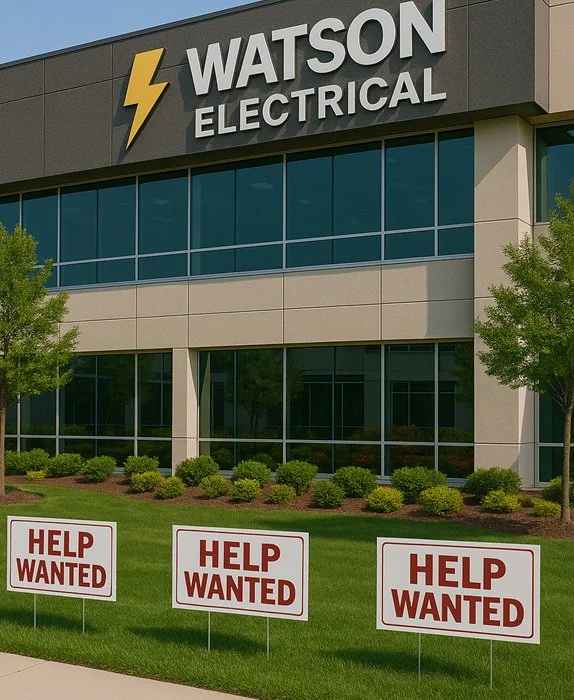How Commercial Electrical Contractors Can Cut Costs 40%
Unlock Your Profit Potential Today
Book your Free Strategy Session with an industry expert.
Get expert insight on scaling profit- no cost, no pressure.
Most commercial electrical contractors make just 2-3% net profit. That's dangerous. Industry experts say you need 10-20% margins to run a healthy business.
For a $10 million electrical contractor, the difference between 3% and 15% profit equals $1.2 million every year. Housecallpro
As a certified business coach, I work with electrical contractors who make $5M to $35M each year. I see profit problems every day.
The gap between what you make and what you should make often stems from hidden profit leaks that most owners never spot. The good news? Smart contractors use new tools and methods to cut costs by 30-40%. Sensgreen
Why do profits stay so low?
Three significant challenges hit electrical contractors in 2025:
Labor shortages keep getting worse. The Bureau of Labor Statistics says we need 80,000 new electricians every year through 2031. However, the workforce is projected to shrink by 14% by 2030, while work demand is expected to grow by 25%.
Material costs jumped fast. Copper wire prices increased by 18% because of the 2025 tariffs.
Delivery times doubled. Contractors with fixed-price contracts had to eat $20,000-40,000 in extra costs they couldn't pass to customers.
Wasted time kills profits, too. Most contractors win only 10-20% of the bids they submit. That means 80-90% of the estimating work generates no revenue. Estimating one $500,000 project costs $1,800 in labor time.
This blog will show you which AI tools can save money for electrical contractors. You'll see how AI drives most of the 40% savings through smarter estimating, scheduling, and inventory management.
Table of Content
Why Commercial Electrical Contractors Lose Money in 2025
The U.S. electrical services market crossed $163.9 billion in 2024. Yet individual contractors struggle with keeping profits. EC&M's Top 50 commercial electrical contractors made $59.5 billion together in 2025.
Yet 59% expect flat margins while only 36% expect profits to grow. Understanding where money disappears helps you know which solutions protect your business. ecmweb
Tariffs Destroyed Material Budgets
The 2025 tariffs on copper, steel, and aluminum changed commercial electrical contracting overnight. Copper wiring costs jumped 18% in almost overnight. Transformers, electrical panels, and switchgear experienced a 15-25% increase in demand.
Material delivery times doubled. Projects waited months for critical equipment instead of weeks.Fixed-price contracts became money traps. Contractors couldn't change contracts signed before the tariffs hit.
“Contractors had to eat $20,000-$40,000 in unexpected material costs per mid-sized project,” stated David Long, the CEO of the National Electrical Contractors Association. He warned that tariffs are a major risk to the electrical construction industry. NECA
Supply chain delays caused schedule problems. Contractors had to constantly rethink their approach to buying materials. They had to adjust timelines repeatedly. Customer relationships suffered when projects stalled because of delays in receiving materials beyond our control.
Labor Shortages Reached Crisis Levels
The construction industry needs 454,000 new workers in 2025 to meet demand.
Nearly 30% of union electricians are close to retirement age. Commercial electrical work requires more extensive training than residential work because buildings utilize higher voltage systems.
Finding qualified electricians who can handle complex commercial work becomes increasingly difficult every month. Analysts project a 14% shrinkage in the electrical workforce by 2030, while they expect demand to grow by 25%.
This creates a huge gap. Labor costs increase as contractors compete for the same limited pool of workers.
Profit Margins Stayed Dangerously Thin
Most commercial electrical contractors work at 2-3% net profit margins. Industry experts say you need 10-20% for a healthy business.
ServiceTitan's research indicates that electrical contractors should aim for a 20% net profit. Yet the reality is that many commercial electricians struggle to reach 10% net profit. Some businesses work at margins as low as 2-3%.
For a $10 million contractor, the gap between 3% and 15% margins equals $1.2 million in yearly profit. Overhead costs account for 25-35% of revenue before pricing any project work. Without careful watching, overhead grows faster than income.
Fixed-price contracts make the risk bigger.
When material costs spike without warning or projects take longer than estimates, thin margins disappear. One project losing $50,000 needs five more projects at a 10% margin just to break even.
Estimating Time Got Wasted on Losing Bids
Most commercial electrical contractors will tell you they only win about one out of every five bids, if that. In some markets, it’s closer to one out of ten. That means most of the estimating work never pays off.
Preparing a bid for a $500,000 project can easily consume 20 to 30 hours of estimator time. Figure around $60 to $80 an hour, and you’re looking at roughly $1,500 to $2,000 in labor for every bid sent out.
If your company bids on 60 projects a year, that’s over $100,000 tied up just in estimating, and you might only land 6 to 12 jobs. The rest is time and money gone.
When you’re counting materials and labor from hundreds of plan pages by hand, it’s easy to miss things that drive costs up and margins down.
Four Solutions That Cut Commercial Electrical Costs 40%
Smart commercial electrical contractors use specific tools and methods that deliver real cost cuts within 90 days. These solutions address the largest profit leaks affecting contractors in 2025.
As a business and executive coach working with $5.0M-$30.0 commercial electrical contractors, I see money bleeding in the following four main areas, and AI can fix these leaks fast.
Computer Software That Reads Blueprints Automatically
Artificial intelligence software reads commercial blueprints and counts electrical parts on its own.
Platforms like Beam AI and Togal.AI finish counting everything in minutes instead of the hours manual work takes.
The software finds wire runs, conduit paths, panels, fixtures, outlets, switches, and equipment from PDF blueprints.
These systems measure distances and figure out how many parts you need. They send data straight into estimating platforms.
Beam AI reports that contractors save 90% of their estimating time. The software automates takeoffs that previously consumed 20+ hours per week, allowing estimators to focus on pricing strategy and winning jobs.
Contractors using Beam AI bid twice as many jobs thanks to the time savings from automated takeoffs. This increased bidding capacity occurs without the need for additional estimating staff.
PataBid users complete 68 bids each year compared to 52 manual bids. This AI-assisted efficiency creates 16 additional bidding opportunities annually, potentially leading to 2-3 additional successful contracts.
AI-powered software reduces errors through consistency. Unlike human estimators who can miss details when reviewing hundreds of blueprint pages, AI systems scan every page and extract all quantities, specs, and notes without fatigue.
The software catches changes from addenda and cross-reference sheets to avoid missing critical information.
The ROI potential is significant. PataBid data indicates that increased bid volume can result in 2-3 additional successful contracts per year. For contractors winning projects with healthy profit margins, even one additional project can offset annual software costs.
One extra $400,000 project at a 10% margin generates $40,000 in profit.
PataBid reports that increased bid capacity can lead to 2-3 additional successful contracts annually. Contractors using Beam AI have increased revenue by $500,000 to $1 million within months of implementation, thanks to bidding on more projects without adding staff.
The time savings from automated takeoffs happen immediately, with most contractors seeing results within the first 90 days of using AI estimating software.
Better Scheduling Systems That Track Your Crews
Scheduling by hand wastes 25-35% of worker time.
Poor route planning causes this. Putting the wrong skills on jobs does too. Modern scheduling platforms connect real-time traffic data, worker licenses, parts on hand, and past job patterns. They use all this to make better daily schedules.
BuildOps lets you drag and drop schedules and filter by licenses, skills, and who's available right now. Systems automatically change routes when jobs take longer than planned. They send emergency calls to the closest qualified electrician.
Workiz helps electrical contractors boost their revenue by 22% through better customer management, scheduling, and payment processing.
The platform sends updates right away, and crews can access it on their phones.
In my business coaching (page 1 home) work with commercial electrical contractors, those using scheduling software report more billable hours without hiring more workers.
When scheduling software helps you recover just 30 billable hours each month at $75 per hour, it generates $27,000 in extra yearly revenue. That's a net gain of over $21,000 after the software cost.
This addresses a profit leak that most contractors don't see until we map out where every hour goes during a typical week.
Inventory Systems That Stop Overstocking
Electrical contractors often stock too many common materials while running short on project-specific items.
This ties up $25,000-$75,000 in extra inventory. Smart inventory systems analyze how you use things, check seasonal changes, and consider upcoming projects. Then they adjust stock levels on their own.
BuildOps provides real-time visibility of your assets across multiple job sites and trucks.
The platform tracks your usage and links transactions to specific jobs. It works with your quotes and invoices. Sortly lets you see things on your phone, alerts you when stock is low, and helps estimate jobs while tracking tools.
InventoryCloud tracks parts, tools, cables, panels, and safety gear in a single system. Features include tracking across multiple locations, easy check-in and check-out, tracking each job or crew's usage, and automatic alerts when you need to reorder.
The software prevents theft by providing complete visibility and maintaining a history of all transactions.
Using inventory management systems helps contractors reduce excess stock and improve first-time fix rates by making sure technicians have the right parts when they need them.
A contractor holding $50,000 in inventory can reduce excess stock, making parts easier to find. This frees up working capital and reduces costly emergency shipping runs.
How to Start Cutting Costs in 30 Days
Implementing solutions successfully follows a clear process that quickly demonstrates value without disrupting operations.
Find Your Biggest Profit Leak
Review 90 days of operations to identify where you incur the most losses.
Write down specific numbers:How many bids did you submit versus how many you wanted to?
Which projects finished below estimated margins and why?
How much overtime did you pay because of scheduling problems?
What percentage of technician time was billable versus wasted?
How much did you spend on shipping emergency parts?
Figure out dollar costs for each problem area. Now, address the highest-dollar problem first.
Solving your largest issue creates quick money back that pays for more improvements. In my coaching practice, this diagnostic process usually reveals $50,000-$200,000 in hidden profit leaks for mid-sized contractors.
Look for Commercial Electrical-Specific Tools
Use platforms designed for commercial electrical contractors, not general construction software. General tools don't support complex commercial workflows.
Request demos and trial periods before committing to yearly agreements. Test software on 2-3 actual projects. Make sure it works with your workflow. Verify that it integrates with your existing accounting and project management systems.
Don't roll out to the whole company right away.
Test with one estimator, single crew, or specific project type. Conduct 60-90 day tests to measure specific results. Be sure to track the numbers frequently, once a week.
Track:
Time saved per bid or task.
Extra bids completed.
How much better the estimates got.
Billable hour percentage changes.
Emergency shipping cost cuts.
Customer satisfaction shifts.
Write down successes and problems. Use test results to make processes better before expanding to teams. Share key findings with the entire company to generate excitement.
Successful tests usually show 15-25% improvements in the target area. Written proof of money back makes it easy to justify expanding the company-wide.
Train Teams Well
Schedule hands-on training using tools on actual work. Video lessons and manuals don't create skill.
Set aside paid practice time before needing to use them on live projects.
Talk about job security worries directly. Explain how tools make skilled workers more valuable by getting rid of boring tasks. Estimators using AI become more productive and useful, not unnecessary.
Select internal ‘champions’ who possess a deep understanding of both technology and operations. These team members help colleagues and customize systems to match workflows.
Expect 2-4 weeks of learning time for most platforms. How much work gets done may dip slightly during adoption, then improve significantly. Stay patient and supportive during transitions.
Key Takeaways
Commercial electrical contractors face tough 2025 challenges, including 18% copper cost increases, doubled material wait times, and labor shortages projected to worsen through 2030 as the electrical workforce shrinks 14% while demand grows 25%.
Most contractors operate at dangerously low 2-3% net profit margins, despite experts recommending 10-20% for healthy operations, which represents over $1 million in lost yearly profit for a $10 million business.
AI-powered solutions achieve significant cost reductions through four key areas: AI blueprint software saves 90% of takeoff time, AI scheduling boosts billable hours by 30%, AI inventory management cuts costs by 35%, and apprenticeship programs address labor challenges.
Successful AI implementation follows a clear 30-day process: identify your biggest profit leak, run 60-90 day test programs, train teams through hands-on practice, measure results, then scale after documenting improvements.
Most contractors see returns within 90-180 days, with one example showing $30,000 annual savings on a $15,000 AI investment, delivering 2x first-year returns that grow as teams master the tools.
Contractors who delay AI adoption fall behind competitors who submit 30% more bids, win 2-3 extra projects yearly, and operate at higher margins through lower overhead and accurate pricing.
The gap between 3% and 15% margins creates life-changing wealth for owners, enabling growth investment, economic downturn survival, and sellable business value instead of working harder to stay even.
Frequently Asked Questions
How much do AI estimating tools cost?
AI counting software for commercial electrical contractors typically costs $10,000–$15,000 annually, while complete AI estimating platforms run $15,000–$20,000 per year. These tools can help secure 2–3 extra projects each year by enabling more bids, resulting in $80,000–$120,000 in additional profit, well above the software cost, and providing lasting returns.
Will AI replace electricians and estimators?
No, AI supports rather than replaces skilled workers. It automates repetitive tasks—such as counting items on blueprints, allowing workers to focus on critical work. With a rising labor shortage projected to worsen by 2030, AI helps fill gaps but doesn't eliminate the need for experts.
How long does it take to see a return on AI scheduling or inventory tools?
Most contractors see benefits in 60–90 days. For instance, AI scheduling that boosts billable hours by 30% can yield an additional $20,000–$30,000 in income during the first quarter. AI inventory systems quickly reduce stock and rush shipping costs, often saving $2,000–$5,000 within the first month.
Are AI tools affordable for smaller contractors?
Yes, AI pricing often scales by company size and users. A contractor with $3 million in annual revenue can start with AI counting tools for under $12,000 per year, typically saving 30–40 hours per month on estimating tasks.
Which AI tool should commercial electrical contractors implement first?
Start with the solution that targets your largest loss. If manual counting is draining your team's resources, prioritize AI blueprint software; if team productivity is your main concern, consider AI scheduling. Always measure losses first, then address the biggest one with AI.
What’s the biggest mistake in implementing AI?
The most common pitfall is failing to train teams on the new software. Contractors may invest $10,000–$20,000 but skip training, leaving the software unused while old habits persist. Prioritize thorough training for all users to maximize value.
Ready to Move from 3% to 15% Margins?
While competitors implement AI to cut costs by 30%-40%, most commercial electrical contractors remain stuck at 2-3% margins. The difference isn't working harder; it's working smarter with the right systems.
I help $5.0-$30.0M commercial electrical contractors identify profit leaks and implement the right AI solutions that deliver results in 90 days.
Schedule Your Free Strategy Call
Discover which profit leaks cost you the most.
Limited availability for contractors who are serious and ready to scale profit, not just revenue.





